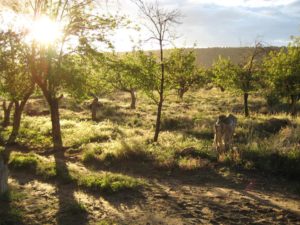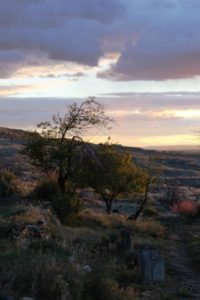Clouds are breaking up; a warm breath of air exposes a patch of sky through the dark overcast- then two  and then three! Our group basks in the new sunshine, warming bones that have been chilled since last night’s rain infiltrated our tents. It is the afternoon of the third day of our stay at Telehogan, a Hopi oasis in the desert. Dorothy, our spry, elderly host has told us that the freshwater spring on the hillside has been watering her ancestors’ gardens for centuries. The lush terraces that she works could date as far back as the first millennium A.D. Throughout the three days that we’ve spent here, she has displayed a willingness to share her heritage and culture with our group of thirteen outsiders. In exchange for her perspective, we are helping her tend to her land: clearing brush, chopping firewood, removing invasive trees, cleaning her water storage cistern and, best of all, planting traditional Hopi heirloom corn in her dry-bed field.
and then three! Our group basks in the new sunshine, warming bones that have been chilled since last night’s rain infiltrated our tents. It is the afternoon of the third day of our stay at Telehogan, a Hopi oasis in the desert. Dorothy, our spry, elderly host has told us that the freshwater spring on the hillside has been watering her ancestors’ gardens for centuries. The lush terraces that she works could date as far back as the first millennium A.D. Throughout the three days that we’ve spent here, she has displayed a willingness to share her heritage and culture with our group of thirteen outsiders. In exchange for her perspective, we are helping her tend to her land: clearing brush, chopping firewood, removing invasive trees, cleaning her water storage cistern and, best of all, planting traditional Hopi heirloom corn in her dry-bed field.
Today marks the day where we dedicate our efforts to planting the corn. The group is split by gender; males tote rakes and Mattocks to clear the field while the women assemble seeds from the best stalks of last year’s harvest. Hopi spiritual beliefs go hand in hand with their agricultural practices. The seeds that they strip from the ears are said to have been genetically linked to those handed down from Masaw at the time of Hopi emergence. As I drive my pickaxe into the moist, sandy soil, I wonder how many generations of Hopi have done the same. This earth is ripe with tradition. Dorothy alone is the third generation of Butterfly Clan to grow traditional crops in this dry soil. About halfway through the brush clearing, a visitor joins us.
A red-tailed hawk has come in for a closer look, landing upon a cottonwood skeleton at our flank. As we swing our tools, the team of landscapers gapes at the sleek bird, which screams occasionally to remind us of its presence- a good omen we suppose. It remains perched throughout our work. Dorothy, accompanied by the rest of the women, arrive seeds in hand. Together, we finish clearing the shrubs and make quick work of the planting process. It feels right planting the seeds in such wet soil. Hopefully it is a sign of a healthy crop. All the while, our curious spectator, the hawk, watches closely, almost as if to supervise our work. The product must’ve sufficed, for near our final row of corn, it gave a final call and took flight- more pressing hawk business to tend to I suppose.
The remainder of the grey day passed. The rain petered out and blue skies became visible through clusters of puffy, saturated cumulonimbus clouds. As the evening drew near, Dorothy halted work. She recognized the need for students to meditate and decompress the day’s activities. When she turned us loose, she said, “Watch the sunset. Moisture in the sky makes for beautiful colors.” Her prediction did not disappoint.
 I took a cup of hohoise, a native herbal tea, to a prominent bluff on the edge of the oasis. Though I was seeking solitude, I was delighted to hear the faint laughter of my companions accompanied by Braden’s melodic narration on his guitar. The sun descended beneath the cottonball cloudline, illuminating the lingering light precipitation. The golden aura gave the entire wash valley an otherworldly hue, signifying the start of a special sunset.
I took a cup of hohoise, a native herbal tea, to a prominent bluff on the edge of the oasis. Though I was seeking solitude, I was delighted to hear the faint laughter of my companions accompanied by Braden’s melodic narration on his guitar. The sun descended beneath the cottonball cloudline, illuminating the lingering light precipitation. The golden aura gave the entire wash valley an otherworldly hue, signifying the start of a special sunset.
The rain ceased, and it was time for the dwindling sunlight to warm our bodies and ignite our senses. The wet, painted desert released a refreshing aroma, grateful for the bounty of new water. The hills bordering our valley exploded into light, boasting a marvelous transition from yellow to auburn to violet, settling into a restful evening darkness. The clouds, once lamented, delightfully caught these tones, radiating the colors from within and below. Their dark centers no longer seemed so ominous as they flaunted the spectrum of the setting sun. The distant San Francisco Peaks were the last to catch the special transition of light. The deep purple lingered upon these sacred peaks, rejecting the night for just minutes longer. While over 150 miles to the west, they appeared as sharply as if we were in Flagstaff through the clear evening air. The desert between us, though infinitely vast, seemed surmountable.
As I was parting ways with the sun, bidding it adieu until the morning, our red-tailed friend returned to the cottonwood, no more that fifty feet from my seat. It too wished to watch the sun take leave beyond the horizon. In a swift primordial scream, it gave its wings a flutter. From the middle of its left wing came a large white feather, twirling to the ground like a propeller. I watched it crest the hill and took a bearing for my eventual retrieval. As I approached, the bird acknowledged my presence, though did not seem to mind the intrusion. Ever-attentive, it continued to watch as I reached for the feather beneath the tree. In my hand, I felt the warmth of the bird radiating from the down at its base, a testament to its recent separation. I felt an overwhelming sense of connectedness to the bird.
With evening nigh, I departed from the ancient cottonwood. Likewise, the hawk took to the air. It circled overhead twice; I could clearly see the absence of a feather in its wing, though it seemed to fly as agile as ever, making a beeline for the southern horizon. At the fire, I presented the feather to Dorothy. Not wanting to violate a cultural taboo, I asked permission to keep it as a token of my experience. She said that the feather was a blessing and that I ought hang onto it.
Thus, I was able to keep my blessing and I encourage readers to seek similar experiences with nature. Tom Fleischner attests that one key characteristic of a natural historian is a deliberate sense attentiveness to the world around us. Every sunset is a blessing and through focused observation we have the ability to experience them as such. Nature is riddled with moments like the one I had at Dorothy’s oasis. One simply must take time to allow them to unfold and revel in their splendor. Attentiveness and consideration for these blessings awaken our spiritual connection to the natural world, deepening our sense of selves, internally and as an element of the greater whole of nature.